- Submissions

Full Text
Peer Review Journal of Solar & Photoenergy Systems
Solar Electrical Energy Systems, Analysis of the Prospects and Possibilities of their Use in the Transportation Fleet
Valentyn Nastasenko*
Doctor of Technical Sciences, Professor of the Department of Transport Technologies of Kherson State Maritime Academy, Ukraine
*Corresponding author: Valentyn Nastasenko, Doctor of Technical Sciences, Professor of the Department of Transport Technologies of Kherson State Maritime Academy, Ukraine
Submission: September 23, 2022;Published: November 01, 2022

Volume2 Issue2 November , 2022
Abstract
The problem of decarbonization of human activity is one of the main ones in the conditions of the growing
threat of global warming. It is solved in different ways in all spheres, first of all - in the fields of engineering
and technology. As part of this problem, the transport fleet could not be aloof from its solution. One of
the ways of its solution is the use of solar electricity power. However, marine solar energy has not been
widely implemented, which requires an analysis of this problem. Its implementation is the main goal of
the performed work, and the search for the most effective implementations of ship solar energy and the
development of recommendations based on this analysis is its scientific novelty.
Work result: It is shown that the energy capacity of photovoltaic solar systems of the economical class
is 0.175 ... 0.185kW/m2, and the annual average, taking into account sunny days, time of day, operating
conditions and location of the system, decreases to 0.02 ... 0.03kW/m2, which significantly reduces
possibilities of their use in the transport fleet. For the real square of placement of ship solar batteries, a
complete replacement of the main engine with them is possible only for pleasure yachts and excursion
vessels. For the transport fleet, it is not possible and can be used only as an additional one, capable of
replacing 3 to 6% of the main engine’s power. However, this is more than the capabilities of other ship
systems that have reached a high level of perfection, which limits their efficiency growth to 1%.
Conclusion: Not using solar energy systems on the transport fleet is equivalent to waste.
Keywords: Marine solar energy; Its real capacities and possibilities; Choice of the best systems
Introduction
The problem of decarbonization of human activity (reduction of CO and CO2 greenhouse gas emissions) is one of the main ones in the face of the ever-increasing threat of global warming. It is solved in the different of ways in all spheres of society, primarily in the fields of engineering and technology [1]. Within the framework of this problem, the transport fleet could not be aloof from its solution. Therefore, the International Maritime Organization (IMO) in Appendix VI of the MARPOL 73/78 Convention introduced restrictions on the emission of harmful substances when burning ships’ fuel [2]. Among the ways to solve this problem, the IMO recommends wind and solar energy [3]. Since marine wind energy requires the creation of quite complex technical systems (for example, masts with sails and their control systems), marine solar energy have fewer problems in its manufacture and implementation. In addition, unlike the wind system, it works even when the vessel is stationary. However, marine solar energy has not been widely implemented, which requires an analysis of this problem.
Analysis of the State of the Problem and Formulation of the Research Task
It is known [4] that the flow of solar energy that reaches the Earth is 1.2∙1011MW, which significantly exceeds the energy resource of other main shipboard alternative sources - wind and waves, since wind is a product of the difference in air heating by the Sun, and waves are a product the wind However, this energy is scattered over the entire surface of the Earth, which is turned towards the Sun and amounts to 1.36kW/m2. At the same time, the real solar irradiation of the Earth’s surface depends on a much larger number of factors: 1) the season (since the Earth’s axis has an inclination of 67.4° to the orbit of rotation around the Sun); 2) the latitude and longitude of the area; 3) geographical and climatic features of the area (the number of sunny days, which is more or less the same for the oceans); 4) the state of the atmosphere (over the oceans its pollution is minimal); 5) placement of the radiation receiver relative to the Sun’s rays and time of day, etc.
The average value of the atmospheric mass, which is accepted
as standard, is the value of АМ1.5 at latitude 42o, which creates a
radiation density of 0.835kW/m2. At the equator at noon, this value
reaches a maximum of 1.25kW/m2 [5,6], the maximum time of
radiation action on Earth is taken to be 3,600 hours per year, which
is taken into account in the further analysis of the efficiency of solar
systems. At the same time, the total solar radiation on the Earth’s
surface consists of 3 components:
A. Direct solar irradiation in the form of parallel rays coming
from the Sun to the receiving area.
B. Diffusion or molecular scattering of solar rays by
atmospheric gases and aerosols.
C. Reflection of rays by the surrounding surface, which for
seas and oceans where there are waves (Figure 1), can reach a value
of 10%.
Figure 1: Scheme of reflection of solar rays by waves [6].

The most promising marine solar power systems are semiconductor photocells, which directly convert solar energy into electrical energy. Semiconductor converters made of chemically pure silicon are the most widely used in modern solar energy, since it is an element widely distributed in the earth’s crust and forms the basis of sand and quartz. The rapid development of solar energy became possible thanks to the reduction in the cost of solar batteries in terms of 1W of power to $3...5 and the increase in their efficiency from 10 to 18%. Production of solar cells based on monocrystalline silicon is a technologically complex and expensive process. Therefore, attention has been drawn to materials such as alloys based on amorphous silicon (a-Si: H). Amorphous silicon is a cheaper alternative to monocrystalline silicon. The first solar cells based on it were created in 1975. The optical absorption of such silicon is much higher than that of crystalline silicon. Therefore, for its significant absorption of visible light, an a-Si; H film with a thickness of 0.5...1.0μm is sufficient, instead of high-cost silicon 300μm substrates. This reduced the weight of the systems, which is important for the transport fleet, as the volume and mass of transport operations is reduced by its value. In addition, thanks to existing technologies for obtaining thin films of amorphous silicon of a large area, cutting, grinding and polishing operations, which are necessary for solar cells based on monocrystalline silicon, are not required. Film structures led to the creation of flexible polymerbased solar cells, such as products of the Italian Solbian company [7]. Compared to polycrystalline silicon cells, photocells based on a-Si: H are manufactured at lower temperatures (300 °C), which simplifies the process, at the same time, you can use cheap glass substrates, which reduces silicon consumption by 20 times and makes products cheaper.
However, the maximum efficiency of the first experimental cells based on a- Si: H was only 12%, which is significantly lower than the efficiency of crystalline silicon solar cells. The search for chemical additives made it possible to increase it to 18%, which is taken as the basis for further analysis in this work. Its implementation is the main goal of the performed work, and the search for the most effective solutions for ship solar energy, and the development of recommendations, based on this analysis constitutes its scientific novelty.
Results of the Work
They are the analysis and development of the most promising marine solar systems. Along with the advantages, solar energy has significant disadvantages, as its peak specific power does not yet exceed the value of 0.175...0.185kW/m2 in the equatorial zone and decreases by 1.5 times in the 40th latitudes. It is reduced by another half due to the dark part of the day and by another quarter due to gloomy days throughout the year. In the light part of the day, it decreases ≈ 2 times due to the low angle of the sun in the morning and evening, so the average annual capacity of solar batteries is 0.025...0.03kW/m2. Since the power of ship’s internal combustion engines for vessels of average displacement exceeds 10mW, significant areas are needed to achieve it, which are not available on the ship. The comparative dimensions of a solar power plant with a peak capacity of 27MW near Lazurnoe, Kherson region, and a modern WARTSILA 7RT-flex 84T-D marine engine with a capacity of 29.4MW are shown in Figure 2.
Figure 2: Solar power plant of peak a 27 MW with an area of 9 km2 and a 29.4 MW WARTSILA 7RT-flex 84T-D engine in its her background.

No transport vessel has such areas, so solar energy systems for them can only be additional. The first fully electric vessel is the largest modern solar-powered catamaran designed and built in Germany, shown in Figure 3; [8]. The surface area of the catamaran’s solar batteries is 500m2 and consists of 38,000 photovoltaic panels, which ensure the operation of 2 electric motors with a capacity of 250kW in a stable mode, giving a speed of 7.5 knots. The catamaran has a length of 31m, a width of 16m, and a water capacity of 85 tons. The solar panels are manually pushed to a width of 32m. You can estimate its dimensions and the conditions of such manual labor by comparing them with the height of people (Figure 3). The ship passed real tests in 2006...2007, circling the Earth near the equator in 584 days (Figure 4).
Figure 3: Catamaran “Planet Solar Turanor” on solar batteries (Germany).

Figure 4: The path of the catamaran “Turanor Solar Planet” during tests in the circumnavigation of the world in 2006-2007.
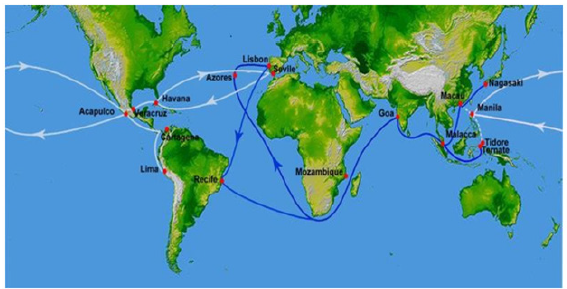
However, the routes of operation of transport vessels cover different latitudes, where the energy performance of solar systems is significantly reduced, especially in high latitudes (Figure 5 & 6) [9], and this is the connection of Europe with North America and China with Europe and North America, where the transport work is up to 50% of the total work of the transport fleet. It should be taken into account that with the average tonnage of ships in the transport fleet of 30,000 tons and the average speed of cargo delivery at 14 ... 20 knots, this project is not very promising in ship execution. With the cost of the catamaran ≈ $12 million, it is significantly inferior in speed to ordinary sailing yachts, and its most effective operation is possible only in the equatorial zone, which prevents the wide introduction of such vessels, even as “toys” for millionaires, there were no orders for the catamaran. To reduce the cost of yachts with solar systems, the Swiss company “Solarwave” and the Turkish shipbuilding company “Nedship” in 2014 built the 62- foot yacht “Solarwave 62” (Solar wave-62) costing about €2 million, which is shown on Figure 7; [10].
Figure 5:Scheme of the main routes of ships in the world ocean [9].
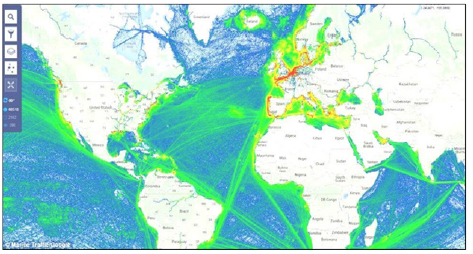
Figure 6:“Solarwave 62” yacht on solar batteries (Switzerland, Turkey).
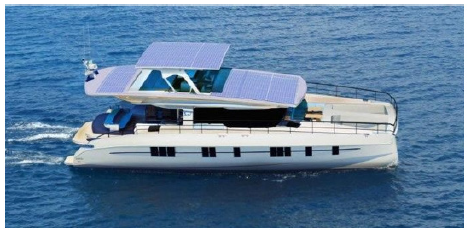
Figure 7:Catamaran project “eCO marine power” (Japan) with a solar energy installation.
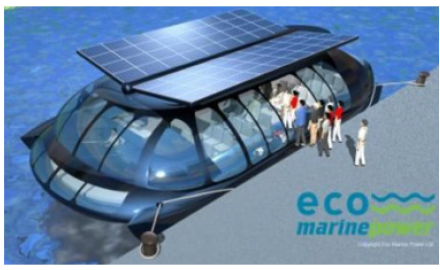
The cost reduction was ensured by reducing the size and water capacity of the yacht, reducing the cost of the materials used and reducing the area of solar panels to 80m2, which led to a decrease in its power to 15kW/h at a specific power from 1m2 to 0.186kW/ (h·m2). As a result, the speed of the yacht decreased to 7 knots. In addition, to meet household needs, either additional solar batteries or a reduction in the power supply of the main electric motors are necessary. In addition to pleasure yachts, with solar systems it is possible to make excursion boats to familiarize tourists with river or sea cities, their bays and the beauties of the coast. The project of such a catamaran “eCO marine power” [11] (Japan) is shown in Figure 7. The vessel is designed for 40 passengers, has a solar battery area of 400m2, a specific battery capacity of 0.185 kW/m2, and total battery capacity of up to 75kW/h. This gives it a cruising speed of 7 knots. Such a project can be used as urban transport instead of automobile. The project of the hybrid sailing-solar yacht “Solar Hybrid Schooner”, of the company “Saunter Carbon Offset Design” (USA), eliminates limitations in the power, which is shown in Figure 8; [12]. Yacht has length of 66 m and combined system of flexible sails-solar batteries, which have an area of 1.6 thousand m2 and are able to use both wind energy and solar energy, which feeds lithium-ion batteries and electric motors with a propeller.
Figure 8:Hybrid solar-sail yacht “Solar Hybrid Schooner” (USA).
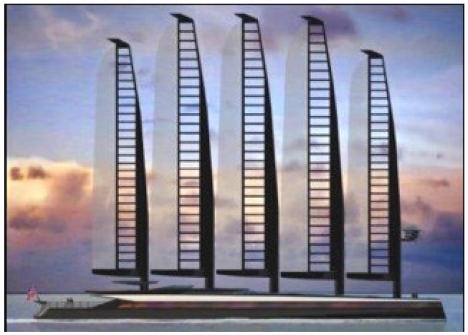
Such a yacht is capable of developing a speed of up to 50km/h (27 knots). Howe stops the action of the sails. Therefore, the cruising speed of the yacht is within 26km/h (14 knots), but this satisfies the conditions of transportation. The disadvantage of the system is the high height of the masts, which creates problems of strength, especially in storms, and problems of passing under bridges. For transport ships, the problems of heeling due to the action of the wind on the mast and the problem of swaying of the ship during gusts of wind are added to them. In addition, it is impossible to use the deck for cargo transportation. It follows from the given data that the energy parameters of solar systems can be effectively used only for small-tonnage yachts with a much lower speed than that of modern transport vessels (7.5 knots versus 14...20 knots). However, the small capacities of solar systems are not sufficient for the values required by the modern transport fleet, especially the large-tonnage one. For example, a small ship (less than the middle class) with a displacement of 8500 tons and a power of the main diesel engine of 5000kW should have the dimensions of the solar panels 310x160m2, at their peak power. This is technically possible if it covers an area of 6 football fields, which makes it impossible to pass through channels, canals and under bridges. Taking into account the average annual power of solar panels, this area increases up to 8 times, so the use of solar energy on ships of the transport fleet can only be additional. Vessels with a large surface area of decks and superstructures, namely covered ferries, tankers, gas carriers, have advantages. However, they are still not enough for a complete replacement of the main diesel engine, and the too large size of the vessel with solar batteries is limited by the conditions of passage of the Panama and Suez canals.
An interesting project of the container ship of the future for 8,000DFE containers: the company Nippon Yusen Kaisha [13], in which solar cells are applied to the closing covers above the containers (Figure 9). Their area of 31,000m2 makes it possible to obtain power up to 10 ... 15% of the power of the main engine and, accordingly, to save fuel for its operation, which reduces greenhouse gas emissions. However, the use of such covers complicates the operation of the vessel and does not exclude their damage during loading and unloading of containers. The covers have an additional weight to the solar panels, which reduces the weight of the transport loads. Designs of ships in which solar batteries are applied to the surface of rigid sails are recognized as more appropriate. An example of such a vessel is the 2025 ferry project “E / S ORCELLE” (Sweden), which is shown in Figure 10; [14], the area of its solar panels generates energy of 3 ... 4% of the energy of the main engine.
Figure 9:Sliding lids with solar batteries for closing containers in the “NYK Super Eco Ship 2030” vessel project (Japan).

Figure 10:Project “E / S ORCELLE” (Sweden) 2025, automobile ferry with a system of rigid lifting sails covered with solar panels.
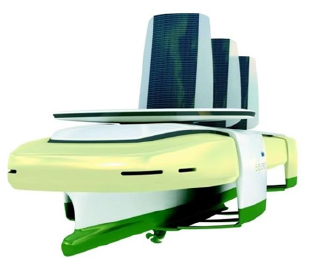
However, a rigid lifting sail is unable to turn when changing the ship’s direction relative to the wind and the sun. This sharply reduces its effectiveness in other directions of the Sun’s action, except for the opposite, which practically reduces the power of the solar system by a factor of 2 compared to the maximum possible.
These disadvantages are eliminated by a ship with rotating rigid sails, which are equipped with solar batteries on both sides. Among them, the project was recognized as the best Eco Marine Power Wind-Solar Ship [15] (Figure 11a & 11b). On the ship, the height of the masts is reduced, they can be raised and lowered on the stand, which facilitates their passage under bridges and also reduces roll and sway. In the new projects of such a vessel, solar batteries are installed not only on the sails, but also on the lids of the holds and on the superstructures (Figure 11b), which increases the produced energy to 4...6% of the power of the main engine of the vessel.
Figure 11:Project of the 2025 dry cargo ship “Eco marinepower” (Japan) with rotating side sails and solar batteries on them [15].
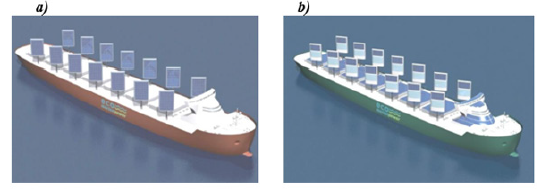
In addition, the batteries have sections for working at night from infrared rays (Figure 12). However, the implementation of solar panels on the lids of the holds does not allow the deck to be used for cargo transportation, which is a drawback of this project. The second disadvantage is the lack of protection of power sails and solar batteries on superstructures from pollen, which is formed during loading and unloading of bulk cargoes, especially coal. Evaporation of sea salts also leads to pollution of solar cells and corrosion of their surfaces, which requires solving these problems. Despite the indicated disadvantages and the relatively small power of solar ship energy systems, the refusal to use the accompanying solar energy on ships should be considered a waste, since this energy already exists and does not require funds for its purchase, unlike other energy sources. In addition, modern marine energy systems have reached such a level of perfection that does not allow saving more than 1% of fuel, so the reserve of 3 ... 6%, which is created by solar energy systems, is a significant result. The limiting factor is the relatively high cost of solar panels.
Figure 12:Eco Marine Power combined power sail.

General Conclusion
A. The conducted analysis showed that the electric energy
capacity of modern solar photovoltaic systems of the economical
class is 0.175 ... 0.185kW/m2, and the average annual, taking into
account sunny days, time of day, operating conditions and location
of the system, decreases to 0.02 ... 0.03kW/m2, which significantly
reduces the possibilities of their use in the transport fleet.
B. For the real areas of the ship’s solar batteries, the complete
replacement of the ship’s main engine with them is possible only
for pleasure yachts and excursion ships during daylight hours, with
their speed limited to 7 knots.
C. With an average speed of cargo transportation in the
transport fleet of 14 ... 20 knots, a complete replacement of the
main ship engines with solar energy systems is impossible and they
can be used only as additional ones.
D. The actual areas for placement of solar panels on the
transport fleet are able to replace 3 to 6% of the power of the main
engine, but this is more than the capabilities of other ship systems
that have reached a high level of perfection, which limits their
efficiency growth to 1%.
E. Failure to use solar energy systems in the transport fleet
is equivalent to waste, since the energy of the Sun does not require
costs for its acquisition and saving the power of the main engine
by 3 ... 6% adequately reduces emissions of greenhouse gases,
which gives an additional effect for the whole society. For the wide
implementation of marine solar power systems, it is necessary to
reduce their cost.
References
- https://www.siemens-energy.com/global/en/offerings/decarbonization-products-solutions.html
- Appendix VI of the Convention MARPOL 73/78.
- (2014) Guidelines on the method of calculation of the attained Energy Efficiency Design Index (EEDI) for New Ships, Resolution MEPC 245(66).
- Gorodov RV (2009) Non-traditional and renewable energy sources. In: Gorodov RV, Grubin VE, Matveev AS (Eds.), (1st edn), Publishing House of the Tomsk Polytechnic University, Tomsk, Russia, p. 294.
- Ageyev VA (2004) Non-traditional and renewable energy sources (course of lectures), Publishing House Leningrad, University Department of Heat and Power Systems, Saint Petersburg, Russia, pp. 343.
- Wallenius Wilhemsen.
- Flexible solar panels.
- Solar Turanor.
- https://spacegid.com/karta-sudov-onlayn.htm
- solarwave-yachts.com
- http://www.ecomarinepower,com/en/energysail
- Solar Hybrid Schooner.
- http://www.nyk.com/english/release/31/NE_ 090422.html
- E/S Orcelle Access mode
- http://www.ecomarinepower,com/en/energysail
© 202 Valentyn Nastasenko. This is an open access article distributed under the terms of the Creative Commons Attribution License , which permits unrestricted use, distribution, and build upon your work non-commercially.
 a Creative Commons Attribution 4.0 International License. Based on a work at www.crimsonpublishers.com.
Best viewed in
a Creative Commons Attribution 4.0 International License. Based on a work at www.crimsonpublishers.com.
Best viewed in 







.jpg)






























 Editorial Board Registrations
Editorial Board Registrations Submit your Article
Submit your Article Refer a Friend
Refer a Friend Advertise With Us
Advertise With Us
.jpg)






.jpg)














.bmp)
.jpg)
.png)
.jpg)










.jpg)






.png)

.png)



.png)






